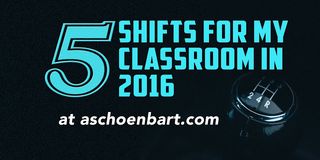5 Shifts for My Classroom in 2016


Good educators are reflective practitioners. We reflect, grow, and improve every day and every year. Our students and the world we all live in keep changing, so we can’t afford not to do the same. But meaningful change must be intentional; it’s important for us all to actively plan to make change happen to do better for our students.
Last year, I reflected on these changes in 5 Big Shifts for My Classroom This Year, which turned out the be one of the most popular posts on The SchoenBlog. I focused on 5 C-phrases: Centered on students, connected learning, creation, a community of learners, and communication.
This year I have the opportunity to reflect on my goals as a teacher, coach, and writer. I’ll likely do so in separate posts over the next few weeks. As a teacher, though, there are a few big ideas that have been rolling around in my head. They’re not fully formed yet, but are the seeds of innovation I intend to develop this year.
And I’d love your help. If you have experience with one of these shifts, can share a resource, or connect me with someone to help, please let me know. I’m looking for advice and reading to push me forward.
1. Rethinking Grades
Right now, I don’t know what to do about grades. For the past few years, I’ve allowed students to revise anything as long as they are coming to extra help, so that students who work hard will always earn the highest grade they deserve. It was more important that they learn and grow than learning in the moment I dictated. But for students who aren’t as motivated? For those who stumble? It was really hard to come back from.
If you’re missing work and not coming to extra help or revising, I didn’t accept the work. Responsibility, timeliness, and management all mattered, too. But I want students’ work to represent their best, yet I also want to celebrate success without punishing failure. I’m not sure what the answer it but I’ve been doing my own summer homework, reading about throwing out grades and homework. Right now, I’m leaning towards a system with more project-based work, where students set their own goals and deadlines as much as possible. Most importantly, they self-assess and peer-assess their own work. How this will translate into points and grades—or even if it will, is a question for another day and post.
What are your grading and homework policies? Are you ready to throw out grades?
Tech & Learning Newsletter
Tools and ideas to transform education. Sign up below.
2. Portfolios, Publishing, and Growth
My students, colleagues, and parents always hear me talk about growth. I’m big on data-driven instruction and celebrating small victories, but I want to do better at documenting the growth and progress. This year, I want to truly embrace online portfolios and publishing work.
Last year, we blogged for #GeniusHour and I shared a lot of student work on social media and right here on the blog. Next year, I want students to be documenting their own growth, reflection, and successes. I’m not sure if that will involve individual student blogs, class blogs, or a Google Sites portfolio, but I’m considering a few options.
Since I want to celebrate growth and success, provide authentic publishing opportunities, and encourage real-world connections, collaboration, and feedback, I’m leaning towards student blogs with a monthly or bi-weekly post showcasing their best work of that time period. I don’t want to force student to share the work that’s not ready (or they’re not yet proud of) but do want to real world publishing for audiences beyond the teacher and even the class.
What portfolio or blog systems do you recommend for high school English?
3. Project-Based Learning
I’m done with direct instruction. I’m done being the one to do the talking. And I’m done being in charge and having control. These statements are partially in jest—I’m not a fan of big blanket statements in education and these don’t really represent my classroom. Over the past few years, I’ve moved towards a much more student-centered approach with choice and voice.
Now I want to involve students more directly in that planning and learning, creating an environment where they can actively create and manage the learning experiences. I love many of my lessons and past teaching experiences, but I think it’s time for something more, and to continue to push the focus from the teacher to the student for more meaningful learning opportunities.
Can anyone share some great PBL resources for high school English?
4. From Engagement to Empowerment
I can keep my students engaged—they are using technology, writing, thinking critically, working collaboratively, and so much more. If you look into my classroom or even follow along on Twitter (@SchoenTellOHS), you will almost always see engagement.
But empowerment? That’s another story. I want to foster a classroom culture that empowers students to be active participants and creators in their learning experiences. A classroom where their voices, interests, and ideas really matter in shaping their learning. I want my students to have the power to direct their learning, to want to have that power, and to want to learn. First, I need to clarify my expectations for empowerment, I think, but echoes of The Innovator’s Mindset are definitely still ringing in my mind, and it seems like the next step forward for my learners.
How is engagement different than empowerment for your learners?
5. Failing Forward (no one left behind!)
I'll end with the largest shift: failing forward. It’s become a buzzword of sorts in education, as we consider growth mindset and the #InnovatorsMindset. I want my students to embrace iteration, creation, and growth. Sometimes, that means failure.
But more specifically for me, I don’t want my students to fail. I don’t want to give up on high standards, expectations, or policies, but I want to do more to show empathy, build character, and recognize the whole child. Our teenagers are so much more than just 9th and 10th grade English students, and I don’t want to lose sight of that in our tight 41-minutes each day. I want a classroom culture where failure is never an endpoint, growth and innovation are the norm, and everyone succeeds.
Some of that (a lot?) is out of my control. It’s idealistic for sure. But it feels right on an emotional, personal, and pedagogical level. If I’m going to work hard to push students forward and to raise expectations, I need to do more to help them get there.
How do you deal with failure in your teaching?
More Shifts to Come
I started the list that became these five shifts back in June, during the last few weeks of the school year. I’m sure I could have easily made it 10, or even 20, but I think this is a good start.
Some of it’s abstract. It’s a little idealist. But for me and my classroom, it feels right. I’ll be thinking about these five ideas and my questions throughout this post over the remainder of the summer months. Expect some follow up on the Schoenblog as I process and grow.
What shifts or changes do you plan for your classroom or teaching in the upcoming school year? Can you help me with advice, ideas, or resources for mine? Please share in the comments or on Twitter @MrSchoenbart.
cross posted at www.aschoenbart.com
Adam Schoenbart is a high school English teacher, Google Education Trainer, and EdD candidate in Educational Leadership. He teaches grades 10-12 in a 1:1 Chromebook classroom at Ossining High School in Westchester County, NY and received the 2014 LHRIC Teacher Pioneer Award for innovative uses of technology that change teaching and learning. Read more at The SchoenBlog and connect on Twitter @MrSchoenbart.










